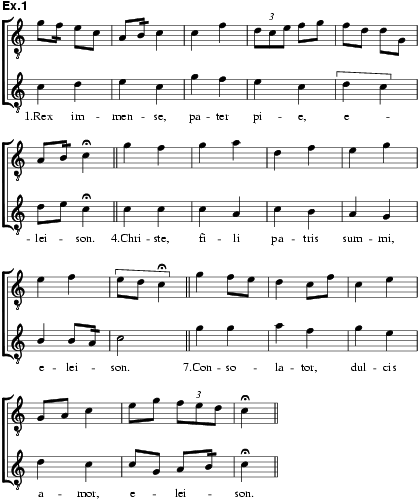
(Middle Eng., from Lat. discantus: ‘singing apart’; verb: discantare; Old Fr. deschant, descant; verb: deschanter).
A type of medieval polyphony having a plainchant tenor, characterized by essentially note-against-note, contrary movement between the voices and the interchange of the consonances octave, 5th and 4th. In the 12th and 13th centuries it was further characterized by the use of the Rhythmic modes, by formally balanced phrase-shapes, and by the fact that the plainchant basis was melismatic. It was not itself a musical form but a technique – in origin a technique for the improvising of two-voice polyphony. In the written repertory it is found within organal plainchant settings and clausulas, and, by abandonment of the plainchant basis and principle of melismatic tenor, also in the conductus. Settings survive for two, three and four voices.
I. Discant in France, Spain and Germany
RUDOLF FLOTZINGER (I), ERNEST H. SANDERS/PETER M. LEFFERTS (II)
2. the distinction between organum and discant.
3. Organum and discant in the ‘Magnus liber’ and its recensions.
4. Discant in three and four voices.
5. Later discant: England and Germany.
Discant, §I: France, Spain and Germany
The Latin word ‘discantus’ came into existence in the 12th century from the Greek diaphonia, either by direct translation or by analogous word-formation. From the beginning, the word carried the implication not merely of ‘sounding apart’ (i.e. the concept of interval and its measurement, as in the Greek term), but also, more concretely, of ‘singing apart’. It thus implied polyphony, which was developed in the West as a method of performing plainchant. This second implication then reflected back upon the original Greek term. Hence in medieval treatises on music the terms ‘organum’, ‘diaphonia’ and ‘discantus’ frequently occurred as synonymous terms for ‘polyphony’. ‘Discantus’, however, as the latest of the three terms, occurred much less often with this general meaning, as will be discussed below. In addition there is the erroneous definition occasionally encountered of ‘discantus’ as genuine biscantus (i.e. ‘double cantus’ or ‘double-song’); this probably has its forerunners in the numerous (and often incorrect) etymologies in musical treatises – ‘dyaphonia, a dya quod est duo’ and ‘diaphonia duplex cantus est’ (see F. Reckow: ‘Diaphonia’ (1972), HMT, §111b).
The meanings of the term ‘discantus’ as it occurred between the 12th and 17th centuries are all intimately interconnected: (i) polyphony in general; (ii) a certain type of polyphony (either to be distinguished from organum, or to be understood as improvised polyphony as distinct from notated polyphony); (iii) the part that is added to the tenor – thus the part that brings this kind of polyphony into being; (iv) the highest part (usually sung by boys) of a polyphonic setting (therefore equivalent to cantus, superius and soprano); (v) the high register of chorally constructed instruments, e.g. recorders, cornets, viols and organ stops. Although polyphony can be seen as the basic factor of each of these categories, a simple historical link should not be presupposed without careful consideration. The first two definitions are the most closely connected and have the greatest historical significance; only these, and with them the third, are discussed here.
Discant, §I: France, Spain and Germany
It is necessary to establish initially whether the first definition is a case of the part standing for the whole, which would make the second definition the original; or conversely, whether the second is a narrowing-down of the first. In other words, was the word ‘discantus’ formed with the intention of providing a separate term for a new or specific type of polyphony? Current research seems to suggest that this was the case.
Despite this uncertainty, an issue possibly of greater importance has been clarified: the question of how the terms ‘organum’ (in the restricted sense) and ‘discantus’ – terms that are normally contrasted within the generic concept of organum (in its wider sense) – differ from one another. For Riemann it was a question of whether there was any difference in kind, or whether the two were simply separated in time. In his Geschichte der Musiktheorie (Leipzig, 1898, 2/1921) he tried to draw a sharp distinction between ‘organum treatises’ – those up to Johannes Cotto – and ‘discant treatises’ – those after him. He saw as real distinguishing features in the latter the rule of the contrary motion between the parts and the gradual increase in importance of the 3rd and the 6th. Against this, Steinhard (1921, p.220) argued that the treatises cited by Riemann did not represent a new style, but merely gave greater emphasis to the principle of contrary motion within the same style. However, this view rested no more than Riemann's on a thorough examination of all the surviving theoretical and practical sources. As usually happened with medieval concepts of this kind, when the concept as a whole went through a process of reformulation, its individual terms also underwent shifts of meaning and usage. Such shifts, however, do not happen in isolation: the things to which the terms refer also change, and these changes do not necessarily come about and become visible all at the same time. Moreover, in the case of ‘discantus’ it would scarcely be possible to undertake a definition without constant reference to organum – itself a considerably more complex concept.
Two different kinds of polyphony are intimated as early as Guido of Arezzo's Micrologus (c1026): one is characterized by parallel movement of the voices, the other admits changes in the interval between the voices. However, no further distinction is made, least of all a distinction of terminology. For this reason Eggebrecht has preferred to regard parallel organum, even in Guido's day, as a technique no longer practised. He sees it as a means of demonstration, or as a kind of technical preparation for the ‘old organum’ which was the first genuinely polyphonic organum (see Eggebrecht and Zaminer, 1970, p.25).
The basis of this improvised (therefore solo) style was a plainchant melody (or specific parts of one) most of whose notes lay above or between the added organal voices. From this stage of technical development there was a growing tendency after about 1100 to place the newly added organal voice or voices above the tenor. The real reason for this development should be sought in practical considerations of performance. Johannes Cotto's solution (see De musica cum tonario, ed. J. Smits van Waesberghe, CSM, i, 1950, p.157), which implies continual part-crossing and in which the organal voice ‘alter per alienos sonos apte circueat’, ought presumably to be seen not only as an injunction to avoid extending the total range too much and to assimilate the range of the new voice to that of the first voice, but also as an experiment in texture. However, this solution seems already to have been found unsatisfactory in France, although evidence of it is encountered in German traditions at a much later date; for, in a note-for-note setting the vox principalis and the vox organalis (i.e. the voice with the chant, and the added voice) can be heard only as an upper and a lower part. Ultimately the natural effect of the lower part as the supporter of the texture was soon realized and was exploited as such. In allotting this function to the most essential voice – the voice carrying the plainsong – the other voice, the one most modern in style, was automatically brought into the foreground of the texture. At any rate, the placing of the vox principalis at the bottom of the texture, as the ‘tenor’, became the rule by the mid-12th century at the very latest.
The most important writings about 1100, probably all of French origin (the so-called Milanese, Berlin, Bruges and Montpellier tracts), described post-Guidonian organum – the ‘new organum’ in its earliest form – in a thorough and rather technical way and mentioned only one form. It was still an improvisatory technique, and was characterized by the prescription of unison or octave at the beginning, and of unison alone at the end. It employed all the intervals designated as consonantiae (thus including the 5th and 4th), interchanging them according to certain prescribed rules that allowed for – indeed, required – both parallel and contrary motion. It also featured a free alternation between syllabic and more or less melismatic delivery, in other words, between the elementary harmonic framework and a practical, ornamented performance involving, inevitably, other intervals as well.
The difference between the syllabic and melismatic types became fully evident only a generation or so later when the ornamentation of the vox organalis developed from being an optional extra into an essential component part. It is no coincidence that there is a sudden increase in written documents containing this music, among them particularly the so-called St Martial and Calixtine manuscripts (F-Pn lat.1139, 3549, 3719, GB-Lbl Add.36881; E-SC; ex.1). The term ‘organum’ might remain as a generic concept, but it now became necessary to have separate names for the two different styles of performance. This was accomplished first in two anonymous treatises (ed. Schneider and La Fage), where clear distinctions are made between, on the one hand, ‘organum’ in the special sense in which tenor notes were long-sustained and the vox organalis had freedom to indulge in extensive melismas and, on the other hand, ‘discantus’ – a style that maintained ‘equalitas punctorum’, i.e. an approximately equal rate of movement in all the voices. Thus the distinction had nothing to do with contrary motion, a feature common to both; it was primarily a matter of sustained-note tenor combined with melismatic vox organalis as against note-for-note settings in two parts (‘punctus contra punctum’), or, more generally, of the dissimilarity or similarity of the parts concerned. (Cf ex.1 and Organum, ex.9.) Thus the very form that diverged further from previous usage continued to be referred to as ‘organum’, while that which owed much more to tradition was called by the new name, ‘discantus’. This may be because ‘organum’ had lost its specific meaning, but may also be due to a certain ‘belief in progress’ that was characteristic of this period (‘organum’ was indeed initially the more significant term, although the relationship was later reversed).

The technical production of an organal voice and a discant voice was in principle very much the same. However, dependence on the movement of the tenor meant that in discant the choice of intervals and the way the voices combined with each other had to be very directly controlled. It was for this reason that the theorists always attached special importance to it.
The rules described earlier, derived as they were from improvisatory practices, now underwent certain modifications. First and foremost, as part of a general change in the status of consonances the 4th receded gradually into the background and was replaced by the 3rd and the 6th. These were at first used only when they moved directly by step to a perfect consonance, but with their gradual acceptance as consonances this rule ceased to be observed.
In the St Martial manuscripts organum and discant occur side by side, but organum was already predominant. A generation later, at the beginning of what is often called the Notre Dame period, it was quite patently the principal form. The balance was radically shifted when, in about 1180, modal rhythm was finally developed and systematized and began to permeate both forms of music (see Rhythmic modes). The view that this new rhythm came to be linked in some way specially with discant, giving it a particular modernity, is a misleading one. The two must have been very closely associated right from the beginning, because the passing and intermediary notes of the old discantus must have played quite a significant part in the development of the first mode (from which the other five were only developed later, evidently on the basis of literary models).
Discant, §I: France, Spain and Germany
This development can be seen most clearly in the context of polyphonic plainchant settings. The most important collection of organa dupla, known as the Magnus liber organi, survives today only in versions dating from the 13th century. The original form of the cycle (1163–82), which is attributed to the ‘optimus organista Leoninus’ (Anonymus 4: CoussemakerS, i, 342), cannot now be reconstructed with any confidence as to detailed points of style; and yet (and this is the most important point) it cannot possibly have been wholly and exclusively in modal rhythm. In the surviving versions it is clear that through successive layers of reworking the melismatic organum sections became more and more repressed and were replaced by more modern modal-rhythmic sections. The result is that, far more than in earlier examples, the repertory of two-voice organum seems to consist of individual sections (see Clausula) of differing structure. (Anonymus 4 ascribed this adaptation to the ‘optimus discantor Perotinus’, but he could only have been referring to the most important and not the sole adaptation; see Magnus liber, Leoninus and Perotinus.)
In this process, of course, it was not just arbitrary sections of the organum that were revised but, rather, those that were particularly suitable: above all, melismatic passages in the plainchant, passages whose text invited emphasis, tenor sections with an essentially striking structure (i.e. symmetrical note-patterns or phrases with some kind of sequential organization), passages that could be transformed into discant-like structures with as few changes as possible, and sections that were traditionally used for this. In any case, the prevailing distinction between organum and discant, that of sustained notes and melisma as distinct from note-against-note, was heightened by the presence or absence of modal rhythm in the voices: this was given authority in the theoretical writings of Johannes de Garlandia and Franco of Cologne. With modal rhythm, the relative amount of movement in the various voices became standardized. (However, quite apart from modal rhythm, the setting of relatively few duplum notes against any one tenor note remained a basic constituent of the new type of discant; the traditional definition of discant as ‘aliquorum diversorum cantuum concordantia’ could still be justified.)
The fitting of such discant sections into pieces of organum was particularly popular, and this undoubtedly has much to do with the modernity of modal rhythm. There was at the same time a reversion to the much earlier principle of executing not a whole chant but only certain parts in polyphony (particular words, sections, especially tropes), and of interpolating these into the monophonic context of plainchant. In keeping with this principle there were sections (‘clausulas sive puncta’) that were, even by polyphonic standards, so often set in polyphony and so frequently incorporated into chant at the appropriate points, that they were assembled into special clausula-fascicles in manuscripts, ready for optional use in this way. Ludwig (1910) thus spoke of them as ‘substitute sections’ (Ersatzteilen).
Over and above this piecemeal interpolation of discant phrases, however, the incursion of modal rhythm also becomes noticeable in the two-voice Magnus liber. Gradually, too, the dupla sections with sustained-note tenor were transformed into modal rhythm or else were composed anew. It soon became essential to introduce a separate name for the intermediate form that occurred between the extremes of non-modal organum and modal-rhythmic discant; with Johannes de Garlandia this contingency came to be called copula (see Copula, copulatio).
As a whole it may be said that the modal rhythm in this repertory initially permeated the upper part (duplum) and only subsequently the tenor – starting with phrases of plainchant that were especially suitable. The reason for this was presumably the inviolability of the plainchant tenor, though there were probably structural considerations as well. Also connected with the swift further development of rhythm, and particularly with the rapid breakthrough of the system of modes, is the fact that during the 13th century the organum sections too became interpretable in terms of measured rhythm (fractio modi,modi irregulares etc.) and that from this time monophonic plainchant (musica plana) can be distinguished from polyphony as a whole (musica mensurabilis).
However, the solving of the technical problems of notation (which have caused much misunderstanding in the study of these areas since the 19th century) was not the only prerequisite for this. Above all, there were the technical achievements in composition, developed in the most far-reaching way within the context of the numerous modal-rhythmic clausula compositions. Composers learnt to utilize the melodic line with its new rhythmic properties as a formal device and as a means of fashioning larger units. The frequent repetition of tenor cadences was linked primarily with an acceleration of tenor rhythm. The rational rhythmic arrangement of the tenor part progressed from groups of irregular longs and duplex longs, by way of regular sequences of single notes and ligatures, to complicated formulae lasting several groups of tones – a development that originated in a more basic artificial need, and one in which the roots of the later phenomenon of isorhythm with color and talea are to be found (ex.2). With their increasing command of the techniques of composition composers began to experiment with voice-exchange, imitation, retrogression, hocket and so on, as in ex.3.
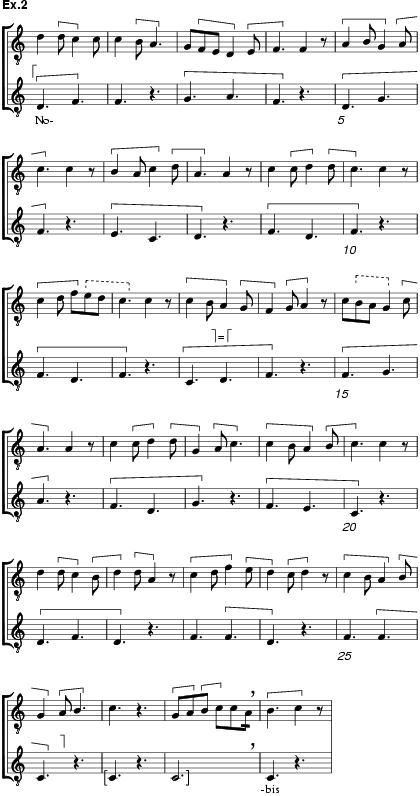
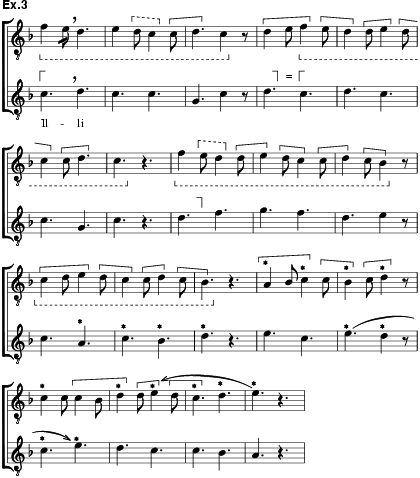
Alongside this development – perhaps the first in the history of Western music to spring directly from a formal, constructional idea – there existed others including developments in subjective response, such as the increasing acceptability of the 3rd as a consonant interval and a complete change of melodic style. Yet the future of discant writing was seen not so much in the clausula itself as in the motet – a form that arose in connection with the clausula by the addition of new text to the upper parts, and which was by then very widely used. This turn of events can be explained not least as a result of the waning interest in plainchant setting as a whole in favour of forms containing repetition patterns.
Discant, §I: France, Spain and Germany
Modal rhythm and discant setting were prerequisites for a progression from two-voice to real three- and four-voice compositions, a development that evidently occurred for the first time with Perotinus in about 1200. Only ‘voices’ that are fixed in an exact rhythm can be combined to form a shaped phrase. This is so even when, as was the case with Perotinus, the voices were composed not simultaneously in relation to each other, but either independently or each one in relation to the tenor alone – and even though, in the spirit of successive composition, some voices might be omitted from or added to existing compositions. These two factors for the first time undeniably produced ‘compositions’ in the modern sense.
Such compositions were designated tripla or quadrupla – terms that served as qualifying adjectives to the noun ‘organa’. The fact that these discant compositions could be so designated merely according to the number of voices demonstrates once again the capacity of the term ‘organum’ to function both as an overall term for polyphony and hence as a specific term for the category of plainchant settings. This does not, however, alter the fact that from the structural point of view these are discant settings, at least as regards the upper voices. Moreover, as these developments proceeded a differentiation in terminology became evident between the style of setting or method of composition on the one hand, and the form or type of music on the other.
This distinction had, however, already emerged in a different way, for not only did discant develop within the context of organum, i.e. of liturgical plainchant setting; it also developed in combination with the early forms to produce the second great genre of composition in Parisian music around 1200 and after, the polyphonic Conductus. The conductus was independent of plainchant, newly used a composed text and tenor part and was used no more than paraliturgically. As well as the problems it has in common with clausula composition, there are specific notational problems arising out of the syllabic underlay of text and simultaneous declamation in all voices. For this very reason, however, conductus generally presents the ‘purest’ and most skilful discant setting of the period, making use of modal rhythm and adhering largely to note-for-note and melisma-for-melisma movement among voices. Significantly, conductus began to fade in France just at the time when it began to duplicate the motet in function and in content. The two differed only in the origin and style of the tenor, and partly in the language of the text.
Discant, §I: France, Spain and Germany
Outside the centres of development, and especially in England, conductus and the particular style associated with it proved considerably more durable, with the result that modern scholars (e.g. Handschin) have sometimes spoken of a ‘conductus style’. As can be seen from the pieces in the 11th fascicle of D-W 677, which are almost certainly British, and the large group of pieces in the so-called Worcester Fragments, the sustained-note style was hardly ever adopted in England. Only discant technique was really ever cultivated. This was at least partly because improvised forms of discant perhaps had a longer and less interrupted history in England, the result being what is known as English discant (see §II below), and meant that the combining of parts to form harmony (in modern terms, the harmonic idiom) could develop more quickly and more concentratedly (ex.4). As a result this tradition was to play an important part in the development of the new sonority of the 15th century on the Continent as well. In German-speaking lands, on the other hand, both conductus and, to some extent, primitive note-against-note ‘organa’ remained derivative and peripheral, marking the end of a tradition.
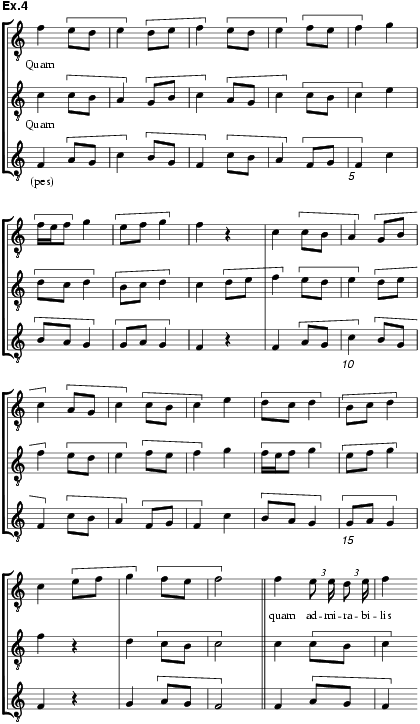
Discant, §I: France, Spain and Germany
In France itself, after Parisian polyphony had ceased to flourish, discant technique was the only new method of composition to be pursued. Organum was still cultivated for some time as a traditional form, but interpreted mostly according to mensural rhythm, which had evolved meanwhile from further developments in modal rhythm. Thus, according to Franco (c1280), organum was already ‘partim mensuratum’, and at the beginning of the 14th century Odington called it a ‘genus antiquissimum’. Otherwise it was rewritten entirely in mensural notation, with no new composition taking place whatsoever. All 13th-century liturgical pieces based on plainchant, including the rapidly increasing number of settings of the Ordinary of the Mass, adopted discant technique exclusively whether they were in the direct tradition of the Magnus liber or stemmed from peripheral or older traditions such as that of the Spanish Las Huelgas manuscript.
From the time of Franco to that of Philippe de Vitry the focal point of interest was the motet. Alongside this the secular song was beginning to develop (including in its sphere polyphonic settings of secular songs in the troubadour and trouvère traditions), and by the time of Machaut it had reached maturity and was at the centre of compositional activity. The first aspect of development in all areas was rhythm. After the modal system had become outdated, the shortest note value available was further subdivided several times over, and similarly the tempo of the basic value was several times decelerated. With the basic possibility of dividing each notational value into two or three, an unprecedented rhythmic diversity was achieved that was exploited to the full in those examples of the late 14th-century Ars Subtilior that today can be deciphered only with difficulty (ex.5). The syncopations, suspensions, anticipations and complementary and counter-rhythms naturally also affect the overall structure, and in particular the harmonic structure of a piece. Nevertheless, so full a use of the rhythmic possibilities did not occur in all the voices of a composition to the same extent; here too, it is evident that the practice was at first to differentiate between the relative movement of each voice, before the gradual equalization of movement set in during the 15th century as a result of influences from other techniques of composition, particularly from Italian canonic writing and English conductus techniques.
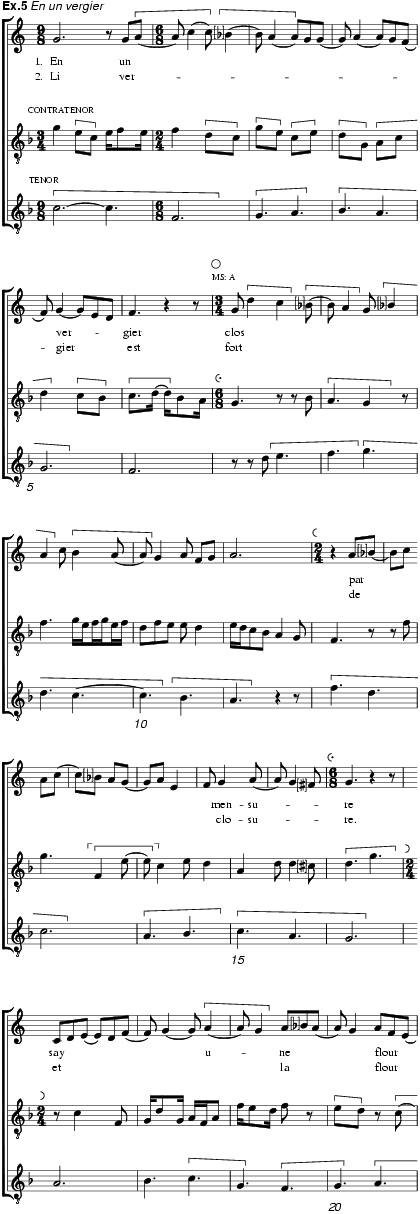
In another respect the development of discant followed the same pattern, though less dramatically. In the treatises of the Ars Nova the earlier advocacy of contrary motion took on the status of a general rule, to be relaxed only in the case of dissonances (imperfect consonances); these might occur in parallel movement, but with no more than four at a time in succession, and at first only in movement by step. In addition, they no longer had to be resolved on to the nearest consonance; they might now lead into a more remote consonance. Finally, one dissonance might follow another (Philipoctus Andreas, Antonius de Leno). Greatest emphasis was now laid (as it had previously been on the succession of (perfect) consonances), upon the carefully balanced succession of consonances and dissonances and their resolution. Dissonance on the penultimate note also became the rule, and when necessary was reinforced by accidentals to ensure the effect of leading note and cadence in the modern sense. (It should be noted that the nature of the phrase was obviously altered by such cadences.)
This particular use of accidentals, even more than the handling of dissonances, shows that composers were beginning to discover the intrinsic dynamic and harmonic potential. Although harmony continued to be the product of several independently moving parts, it now emerged more and more independently into the foreground. Together with this change in aspect of the tonal system came the fact that the Greek notions of interval were finally replaced by the Latin ones, that the distinction between major and minor 3rds became a less important factor than hitherto, and that the acceptability of the two as consonances was exchanged with that of the 4th.
Discant was also designated ‘contrapunctus’ for the first time as early as the treatises of the Vitry school and of Johannes de Muris. This designation, which had been developed from an earlier definition of ‘discantus’, soon became prevalent once the school of opinion gained ground that no longer construed musical style as the product of several ‘voices’ but viewed it rather as a combination of sound. The rules governing successions of consonances in discant soon became transformed into the part-writing rules of counterpoint. Thus counterpoint now stood in the same relationship to discant as discant had done previously to organum. Finally, in the 15th century, counterpoint achieved dominance.
Discant against a ‘cantus planus’ (‘playnsong’) is reported, in more or less detail, in several 14th- and 15th-century English treatises. The various descriptions show that with respect to contrapuntal rules and procedures discant in England did not differ from the general European discant tradition of the time. It involved, in the main, note-against-note counterpoint, with the cantus firmus in the lower of the two voices, contrary motion as the basic condition, prohibition of dissonances and of parallel 5ths and octaves, and recommendation of imperfect consonances, of which the various English authors respectively allowed three, four or five in parallel succession. (While ‘the old techyng was that a man shal never take none imperfite acord bot if he hade a perfite after him’, the English with their traditional fondness for imperfect consonances welcomed the proliferation of 3rds and 6ths in discant with such remarks as ‘the mo inperfite tones that a man synges in the trebull, the meriere it es’, and ‘this maner of singyng is mery to the synger and to the herer’.)
Three characteristics set the English tradition apart from that of the Continent: (i) the recognition, by the mid-14th century, of the possibility that the cantus firmus might be carried by the upper voice, to which the lower voice could fit a discant; (ii) the differentiation of voice ranges (‘degrees’) in which a discant above a cantus firmus could be accommodated, and the designation of the voices as mene, treble and quatreble (also referred to as ‘degrees’); and (iii) the ‘sight’, which was a technical device applicable to the improvisation of a discant. The second of these features can be traced back to at least the third quarter of the 13th century in England, when Anonymus 4 differentiated three ranges for the discant above the tenor as ‘ex propinquis’, ‘ex remortioribus’ and ‘ex remotissimus’ (CoussemakerS, i, 357; F. Reckow, 1967, p. 75). The third feature emerged in the late 14th century.
John of Tewkesbury (CoussemakerS, iv, 294a; also iii, 360b), who wrote his treatise Quatuor principalia in 1351, and the approximately contemporaneous Anonymus 5 (CoussemakerS, i, 367–8), the anonymous Regula discantus (GB-Lbl Add.21455, ff.6-7) and the anonymous Circa modum discantandi GB-Lbl Add.21455, ff.9v-10v), all recognized that a discant could be sung below a cantus firmus. John pointed out succinctly that the same contrapuntal rules apply for this as govern the invention of a discant above the plainchant. The Regula sanctions this activity only in a discanting voice called ‘counternote’ that ranges around the tenor, sounding unisons, 3rds, 5ths, 6ths and octaves above and below, and on occasion reaching a 10th; this voice begins on a unison, 5th or octave above or below and cadences on one of the latter two intervals, also above or below. The far more detailed description by Pseudo-Chilston (see below) in essence demands the same contrapuntal procedure, except that he differentiated between two voices, countertenor and counter (‘countir’). The former shares its range with the plainchant, so that, according to whether a passage of the cantus firmus lies high or low, the countertenor may correspondingly either descend as far as an octave below or ascend up to an octave above. The counter, on the other hand, lies below the plainchant; it may form a unison with it, but cannot cross it. ‘Properli’, the largest interval the counter can form under the cantus firmus is an octave; however, ‘yf ye have a low voice, whan the plainsong gothe hye’, the counter may also use the 10th, 12th, 13th and 15th.
The other two special features of discant in England are reported in the following treatises, all of which survive in English manuscripts datable from the first half of the 15th century, although some of the treatises were probably written in the later years of the 14th century: (1) Anonymous, GB-Lbl Add.21455, f.9; (2) Regula discantus and (3) Circa modum discantandi, in the same manuscript; (4) Richard Cutell (Opinio Ricardi Cutell de London), GB-Ob 842, ff.48r–48v (Cutell is documented as a member of the college at St Paul’s in 1394 and as cardinal a year later); (5) Anonymous, GB-Ccc 410, II, ff.13v–15v; (6) Anonymous, GB-Lbl Lansdowne 763, ff.113v–116v (the so-called Pseudo-Chilston, who, in addition to his treatment of discant, countertenor and counter, and a passing reference to gymel, also discussed faburden); (7) Leonel Power, in the same manuscript, ff.105v–113. The last two items of this list are part of the compilation of musical treatises made by John Wylde some years before 1450. The second and third treatises are in Latin; the Regula designated the ranges as ‘primus gradus’, ‘secundus gradus’ and ‘tertius gradus’, thus relating it to some later Italian discant theory, while Circa modum designated the discanting voice as ‘medius’, ‘triplex’ and ‘quadruplex’ respectively. All the other treatises are in English.
The three ‘degrees’ of discant are defined in terms of the consonant intervals each may form with the cantus firmus. For the mene these lie between unison and octave, for the quatreble (‘this degre of descant longith to a childe to syng’) between octave and 15th, while the treble is variously defined; chiefly, its intervallic range lies between 5th and 12th.
Although the rules of discant contained in the treatises address musicians generally, including composers (‘for hem that wil be syngers, or makers, or techers’, as Power put it in his first sentence), the sight system as an aid in the craft of improvising a discant (i.e. ‘first-species’ counterpoint) seems specifically applicable to singers and teachers. In order to enable a singer to improvise a proper discant supra librum it instructs him to visualize, in the staff on which the plainchant is written, the intervals he chooses to sing above the successive pitches of the cantus firmus. This is easily done in the case of Pseudo-Chilston's countertenor, but requires mental transposition (called ‘fictus visus’ in Circa modum) for all the other voices, since, as the author of the Latin treatise pointed out, the higher ranges of traditional discant, especially of a boy treble or quatreble, would otherwise force the performer to imagine a cumbersome staff of a great many lines (or leger lines). Power, who did not discuss the mene, stipulated mental downward transposition of an octave (see illustration and ex.6).

In the other treatises, however, the transposition interval generally depends on the type of voice. For instance, the mene, whose range is a 5th above the tenor, has to ‘ymagine’ his part a 5th too low, so that the interval of the 5th, with which he must begin and end, appears in his mind's eye as a unison on the staff, while ‘the 3de benethe in sighte is a 3de above in voise’, and so on. In other words, in order to be able to operate within the given staff he applies a sort of double vision to it by visualizing a second clef two lines lower than the original. The same system applies to the other voices: the respective downward transposition intervals for the treble and quatreble are the octave and the 12th, while the counter imagines his part a 5th higher than it sounds (a 12th higher for the 13th and 15th, since ‘ther is no sight benethe the plainsong within 4 rwlis and 4 spacis that will serve it, but yf ye chonge your sight’).
The term ‘sight’ (see Sight, sighting) actually had several related meanings: (i) imaginary transposition; (ii) the range of a ‘sighted’ voice (both ‘in sight’ and ‘in voice’); (iii) that voice; (iv) descant by means of ‘sighting’. In the later 15th century Hothby and Guillelmus Monachus still reported the treble sight of English discant, calling it discantus visibilis and perfectio ocularis. Their testimony as well as that of Nicolaus Burtius shows that the practice not only continued in England, but had also been adopted on the Continent.
The English treatises have been misinterpreted repeatedly in two important respects: English discant has been said by Bukofzer first to involve two simultaneously discanting voices, which secondly combined with the plainchant in the lowest voice to form mostly parallel 6-3 chords. This view has been proved invalid (by Georgiades, 1937; Kenney, 1959; Sanders, 1965). The hypothesis that an unwritten tradition of such parallel discant existed in England before the 15th century is supported neither by factual evidence nor by probability. While in the 13th century ‘discantus’ was an umbrella term comprising the various species of polyphonic music (for two, three or four voices), in the course of the 14th century it became restricted to the meaning described in this article, i.e. one ‘first-species’ counterpoint above a cantus firmus. Only John of Tewkesbury, in Quatuor principalia (CoussemakerS, iv, 294; also iii, 361a), reported a type of discant polyphony consisting of more than two voices, i.e. cantus firmus, two (or three) higher voices paralleling it in 5ths, octaves (and 12ths) in ornamental fashion, and one discant. Yet, in effect, this passage clearly remains within the bounds of tradition by describing how one discant can be applied to a cantus firmus, amplified by old-fashioned doubling. As John pointed out, it sounds like a complex affair (‘plures homines discantare apparent’), although ‘in rei veritate’ there is only one discantor. The remark of Anonymus 5 (CoussemakerS, i, 366b) that ‘totus generalis modus cantandi consistat aut in octavo aut in sexto’, which might be cited in support of 6-3 chord parallelism in discant, is not elaborated and remains inconclusive. All other authors restricted the use of parallel imperfect intervals (see above).
English composers of the 14th and early 15th centuries wrote a considerable number of discant compositions (res factae) that are sometimes mistakenly associated with the conductus. Most of these consist of three voices, with the cantus firmus allotted to the middle voice. (Editions of much of the repertory appear in PMFC, xiv-xvii and CMM, xliv, 1967.) In its simplest and least attractive aspect this style is nothing more than note-against-note discant (ex.7). But in most cases at least the top voice was given a somewhat livelier profile; subsequently, the bottom voice, too, often received more attention from the composers (ex.8). There is no question, however, but that almost invariably only minimal adornments of a strictly functional style are involved; the rarity of 6-3 chord parallelism corresponds to the restrictions placed by the treatises on the use of parallel imperfect consonances. The bottom voice of some of these settings was later extracted as a Square.
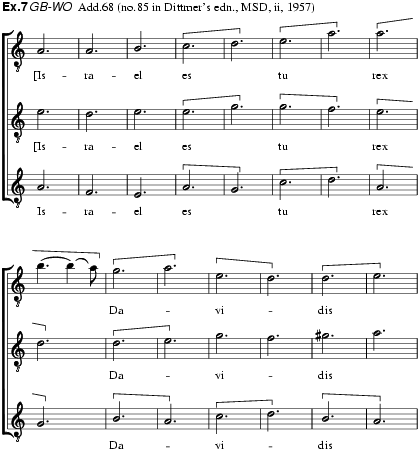
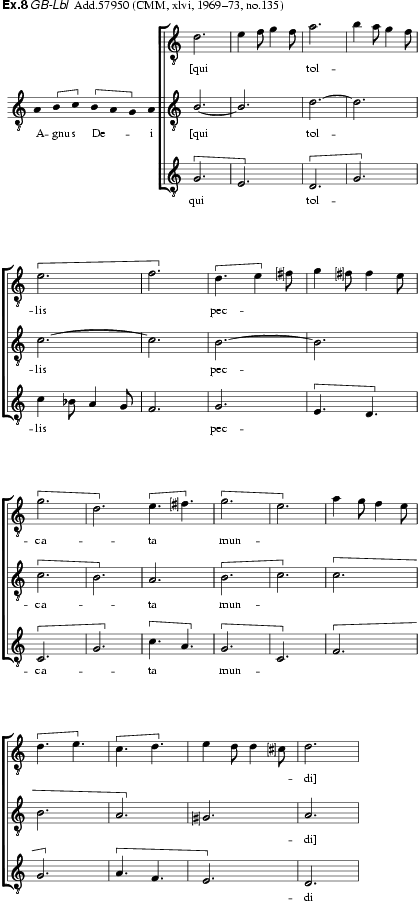
The significance of these compositions is twofold. In the first place, the gradual expansion of the overall range brought with it the genesis of the counter, and allowed composers to turn more or less tentatively to designing bottom voices that had the quality of giving greater support than was possible by the generally conjunct style of Gregorian melodies. Secondly, since most of these compositions are settings of choral chants, both their stylistic modesty and their liturgical purpose indicate that such music was not solo polyphony (as in the preceding centuries), but was intended for a small chorus. The emergence of the latter as a new performing medium of cantus firmus polyphony obviously required a relatively simple repertory. The institution of the performance of ritual polyphony by balanced choral groups is a corollary of the expansion of the two-voice framework to two octaves. These various circumstances bear witness to the gradually increasing importance and musical expertise of the choirs of non-monastic institutions, such as collegiate churches, colleges and court chapels.
For bibliography see Organum.